Easy Miso Soup Recipe
This miso soup recipe is quick, easy to make in minutes, and tastes wonderful any time of year. It’s arguably one of the best parts of Japanese cuisine.
Miso soup is a fantastic start to a meal. It’s brothy, has tons of umami, and the flavor is truly hard to beat.
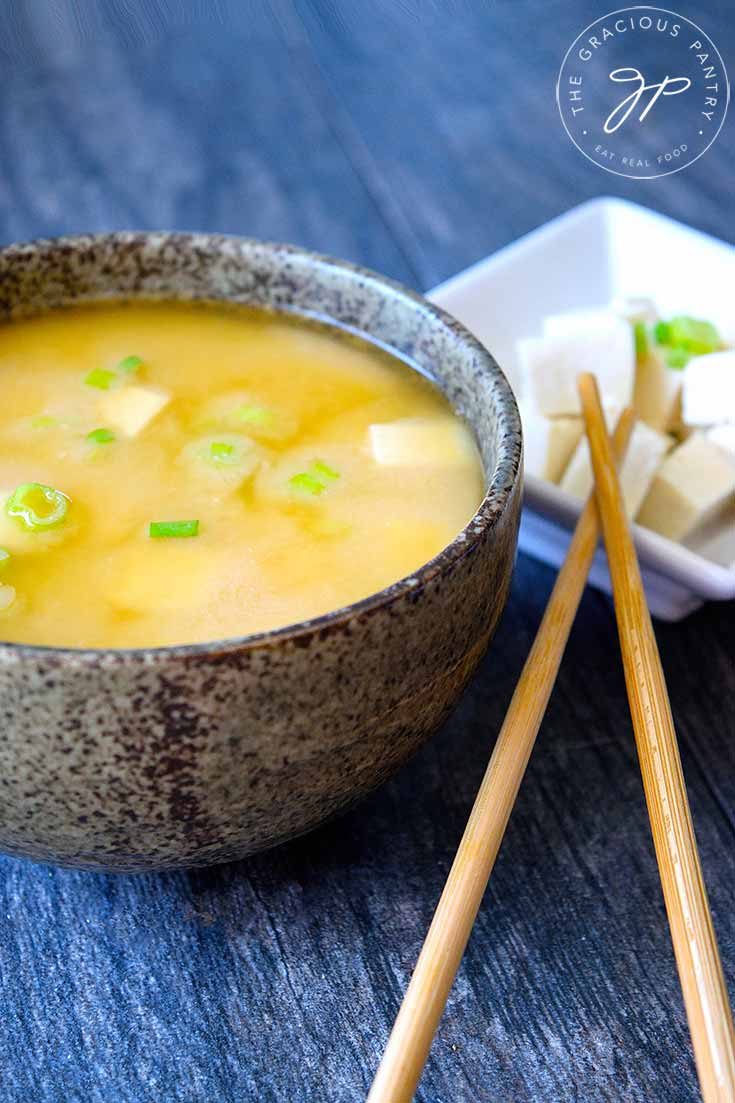
This soup is also amazing when you’re feeling under the weather. It soothes a sore throat and warms up any chills you might have. It’s nourishing, comforting, and just a bowl full of yum.
I recently bought some vegan white miso paste that I used to make a peanut sauce and figured it would be great to toss in some tofu and green onions and just make a small bowl of simple soup. It felt good on his throat and great in my tummy, and he loved the rich, savory flavor (also known as umami flavor). He is definitely a miso soup fan now.
What Is Miso?
Miso is a traditional Japanese seasoning produced by fermenting soybeans with salt and kōji and sometimes rice, barley, seaweed or other ingredients. (source)
It is often used in Japanese cooking. On its own, it’s incredibly salty and pungent. But mixed in with some water and other ingredients, you’ll have a wonderful, savory soup that is perfect for everything from a nice dinner to when you’re under the weather. This fermented paste has many vitamins, minerals, and beneficial bacteria.
Note that there are different types of miso. Notably, white miso and red miso (which is a darker miso with a more pungent flavor). For this recipe, I used white miso, also known as Shiro miso. It is a bit lower in sodium than red miso.
What Is Miso Soup?
As stated above, miso is fermented soy turned into a fermented soybean paste. Fermented food has been shown to have many health benefits. But what you put into the miso broth once the miso has been mixed with water is altogether different.
This traditional Japanese soup typically includes cut tofu and green onions. However, you could also add shredded carrots, bok choy, shiitake mushrooms, small broccoli florets, or any other vegetables you prefer. It’s pretty versatile.
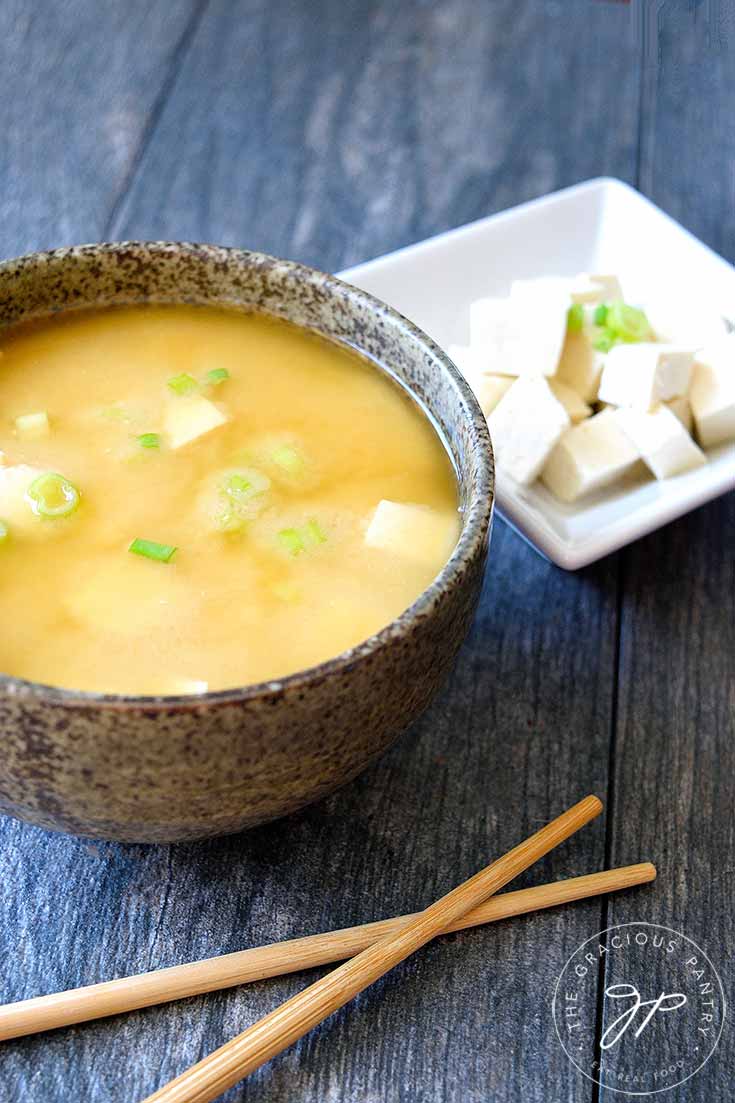
Traditional Miso Soup
Please note that this is not classic miso soup. The traditional version, like much of Asian food, has much tradition and preparation behind it. Ingredients found in an Asian market can sometimes be hard to find here. So, I had to make do with what I had. And I actually got pretty close to what you get in Japanese restaurants!
Traditional Miso is made with ingredients such as dashi stock. A broth made with nori (dried seaweed, also called dried wakame) and/or kombu (dried sea vegetable). Instant dashi is something you can find in many Asian markets if you want to try it but don’t want to mess with the broth-making process of homemade dashi.
What Type Of Tofu Should You Use In Miso Soup?
Honestly, I’m sure there is a traditional type that is most often used. But I’m not a tofu aficionado. I use the tofu that has the texture I like best. In this case, either silken tofu (very soft texture), or extra-firm tofu (for a bit of heartiness) will work well here.
Timing
This soup comes together in under 15 minutes.
Sodium
Note that miso soup is always high in sodium. So, if you are watching that, make sure you use low-sodium tamari and keep your portion sizes smaller. There really is no way around the higher sodium content of miso paste. At least not that I have found. But we both enjoyed this immensely!
(Nutrition data below does NOT reflect the use of low sodium ingredients)
Recipe Additions
Want to make this a more robust soup? Here’s a list of possible additions:
- Ramen noodles
- Sesame seeds
- Spinach
- Scallions
- Cabbage
- Carrots
- Edamame
- Kale
- Daikon radish
What To Serve With Miso Soup?
As a side for this soup, try any of the following:
- Teriyaki anything
- Rice
- Stir-fried vegetables
- Wasabi peas
- Shrimp
- Any other Japanese-style main courses.
Miso Soup Recipe Ingredients
Water – I used distilled water.
White miso paste – I get mine at Whole Foods, but I’m sure many grocery stores carry it. If you can’t find the white version, you can use brown. It will have a deeper, earthier flavor, but it will still be delicious!
Tamari – This measurement is a starting point. For flavor, you can use as much as you like. Low-sodium Tamarai is best.
Firm tofu – You’ll only be using ½ a block. Cut it into ½ inch cubes.
Green onion – This is for garnish, but it also adds fantastic flavor. I can’t imagine Miso soup without green onions! Just remember to slice them thin.
How To Make Miso Soup
In a medium pot, combine the water and miso. Over high heat, whisk until the miso is completely dissolved in the water. Reduce heat to medium.
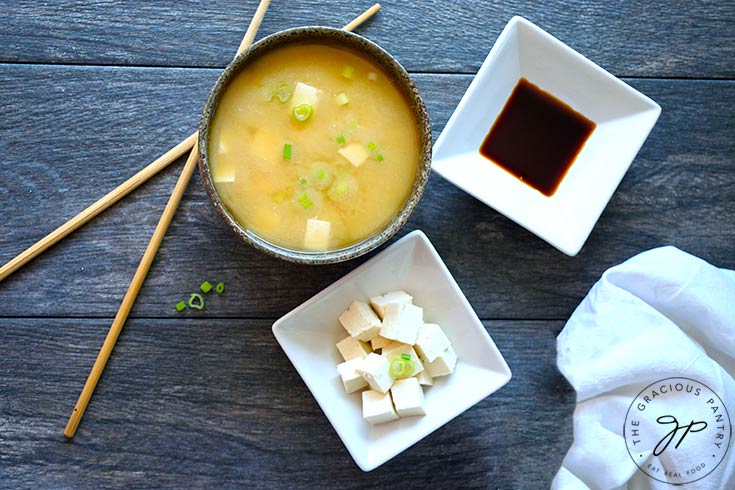
Add in the tofu and the white part of the green onion and bring to a gentle simmer or very light boil.
When the tofu is warmed through, Stir in the tamari and serve with a garnish of the green parts of the green onion.
What To Serve With Miso Soup
Just about any Japanese dish can be paired with miso soup, but my favorite is sushi, especially a really good avocado roll. And if you want to add noodles to this, some soba noodles are always a tasty option.
More Healthy Soup Recipes

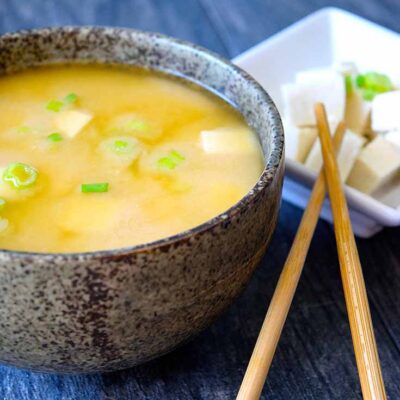
Miso Soup Recipe
Ingredients
- 4 cups water
- 4 tbsp. white miso paste
- 2 tbsp. tamari (or more to taste – low sodium is best)
- 7 oz. firm tofu (½ a block cut into ½ inch cubes)
- 1 large green onion (sliced thin)
Instructions
- In a medium pot, combine the water and miso. Over high heat, whisk until the miso is completely dissolved in the water. Reduce heat to medium. Add in the tofu and the white part of the green onion and bring to a gentle boil.

- When the tofu is warmed through, Stir in the tamari and serve with a garnish of the green parts of the green onion.

Notes
Nutrition
This recipe is from the Gracious Pantry® archives, originally posted 11/19/19.


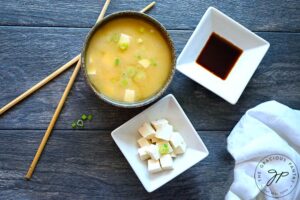
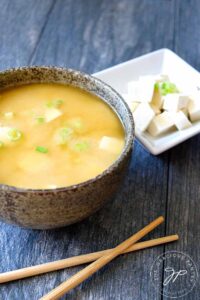

Here are some comments on your miso soup recipe; it’s a decent recipe but you may be interested to know some more details on how it’s commonly made in Japan. Traditionally, miso soup is made with a stock (rather than water). The stock (sometimes referred to in English as “dashi”) is usually made with kelp, dried fish, shaved bonito (katsuobushi which is from bonito), or shiitake mushrooms (sometimes the water used to reconstitute dried shiitake). Plain water is used when kelp is being used as the “filler” (sometimes with tofu but sometimes alone or with green onions) using small clams (asari, generally not available in the US) because the clams create a stock. If you’re using a vegetable that needs to be cooked, it usually gets cooked with the stock source. This would the case with something like daikon (Asian radish), which is usually cut into match-stick form. The reason for this is because miso is not supposed to boiled. I tried making the soup with starting with miso and boiling it, and miso added at the end with the miso dissolved off the heat. I preferred the latter but that may be because that’s what I’m accustomed to. You use white miso. Have you tried red miso? It’s pretty good and more common in the northern half of Japan; white miso is more a southern thing. I grew up with a mix of the two being commonly served. Also, you can find miso which still has some pieces of the soy beans (with soy bean pieces is “tsubu-miso” and with the soy bean pureed is “koshi-miso”); this is an individual preference matter.
YK – Yes, I’ve tried red miso. I went with white miso simply because it gave me the closest result to what I get in restaurants here. Thanks for all the feedback! I don’t know a ton about Japanese cooking, so I appreciate the insight! 🙂
Yes, I have a wonderful cookbook, Washoku, by Elizabeth Andoh, and have been making miso soup through her direction. You need to start with dashi (explained by YK). So much more flavor and will seem like the “real” thing you get in a good Japanese restaurant! It is soooo easy, but the ingredients will be difficult to find unless you go to an Asian market. Worth giving it a try!
Chris – Ya, part of what I try to do here is to make sure people can get the ingredients. Not everybody has access to that sort of stuff. But I think I got pretty close to what I’ve gotten in restaurants, though I’m sure your way is excellent! 🙂